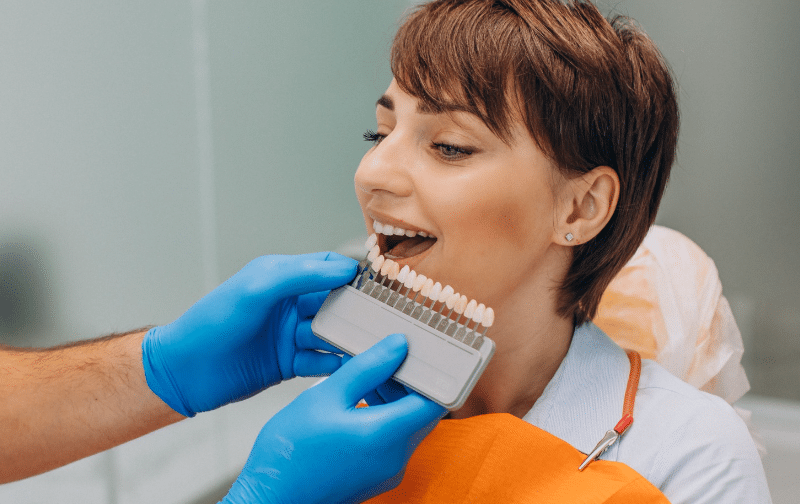Are you unhappy with your smile because of chipped, stained, or misaligned teeth? Are you aware that you can fix these issues with a simple procedure known as “dental bonding?” Read on to find out how this minimally-invasive technique can help restore the perfect balance of form and function in your smile!
What is Dental Bonding?
Dental bonding is a procedure in which a tooth-colored resin is applied to the surface of a tooth and then hardened with a high-intensity light. Bonding can be used to repair cracked, chipped, or discolored teeth as well as close gaps between teeth. The procedure is quick and relatively painless, and it can usually be done in one office visit.
Benefits of Dental Bonding
Dental bonding is a cosmetic dentistry procedure that can be used to fix minor imperfections in your smile. Bonding can be used to repair cracked or chipped teeth, close gaps between teeth, and change the shape or color of teeth.
Bonding is usually done in one office visit and does not require anesthesia. The bonding material is applied to the tooth and then hardened with a UV light. Bonding can last for several years with proper care.
Bonding is a less expensive option than veneers or crowns, and it can be done in one office visit. Bonding is also a good option if you have sensitive teeth or gums and cannot tolerate more invasive procedures such as veneers.
Common Uses For Dental Bonding
Dental bonding is a popular cosmetic dentistry procedure that can be used to fix a number of minor imperfections in your smile. Bonding can be used to repair chipped or cracked teeth, fill in gaps between teeth, and change the shape or color of teeth. This process is quick and easy, and it can usually be completed in just one office visit.
Preparation for Dental Bonding
Dental bonding is a quick, easy, and affordable way to fix minor imperfections in your smile. The first step is to schedule a consultation with your dentist to discuss your goals and concerns. During the consultation, your dentist will examine your teeth and gums to make sure dental bonding is right for you.
If you decide to move forward with tooth bonding, the next step is to have your teeth cleaned and polished. This will help ensure that the bonding material adheres properly to your teeth. Once your teeth are clean, your dentist will select the bonding material that best matches the color of your teeth.
The final step is to apply the bonding material to your teeth. Your dentist will use a special light to cure (harden) the material so it bonds securely to your tooth. Dental bonding can be used to repair chipped or cracked teeth, close gaps between teeth, change the shape of teeth, or improve the appearance of stained or discolored teeth.
The Procedure for Dental Bonding
Dental bonding is a quick and easy way to fix minor imperfections in your smile. The procedure is simple and can be done in one office visit. Here’s what you can expect during dental bonding:
First, your dentist will select the right shade of tooth-colored composite resin to match your natural teeth. The tooth will then be prepared for the bonding material by roughening up the surface. This helps the resin bond better to the tooth.
Next, the resin will be applied to the tooth and shaped to blend in with your natural teeth. A high-intensity light will then be used to harden the resin. Finally, your dentist will check the bonding material for any gaps or rough spots and make any necessary adjustments.
Aftercare and Maintenance of Dental Bonding
It is important to take care of your dental bonding to ensure that it lasts. Here are some tips on how to care for your bonded teeth:
- Brush and floss your teeth regularly. This will help to keep the bonding material clean and free of plaque.
- Avoid chewing hard foods or using your teeth as tools. This can damage the bond and cause it to break down prematurely.
- See your dentist for regular checkups and cleanings. This will help to extend the life of your dental bonding.
By following these simple tips, you can help to ensure that your tooth bonding lasts for many years to come.
Alternatives to Dental Bonding
There are a few alternatives to dental bonding that can be used to fix minor imperfections in your smile. These include:
- Dental veneers: Veneers are thin, custom-made shells that are designed to cover the front surface of your teeth. They can be made from porcelain or composite resin, and can be used to correct a number of cosmetic issues, such as gaps, chips, and misshapen teeth.
- Dental crowns: Crowns are like veneers, but they encase the entire tooth instead of just the front surface. They can be made from porcelain, metal, or composite resin, and are often used to restore damaged or decayed teeth.
- Invisalign: Invisalign is a clear braces system that uses a series of invisible aligners to gradually straighten your teeth over time. It is an alternative to traditional braces and is virtually undetectable when worn.
If you’re not sure which option is right for you, talk to your dentist about which would best suit your needs and smile goals.
Conclusion
Dental bonding is a great way to fix minor imperfections in your smile. It is relatively inexpensive, and the results can be quite dramatic. The process only takes one visit to your dentist, so if you are looking for a quick fix that won’t break the bank, dental bonding might be the best option for you. With proper care and regular dental checkups, your newly bonded teeth should last for many years to come!

